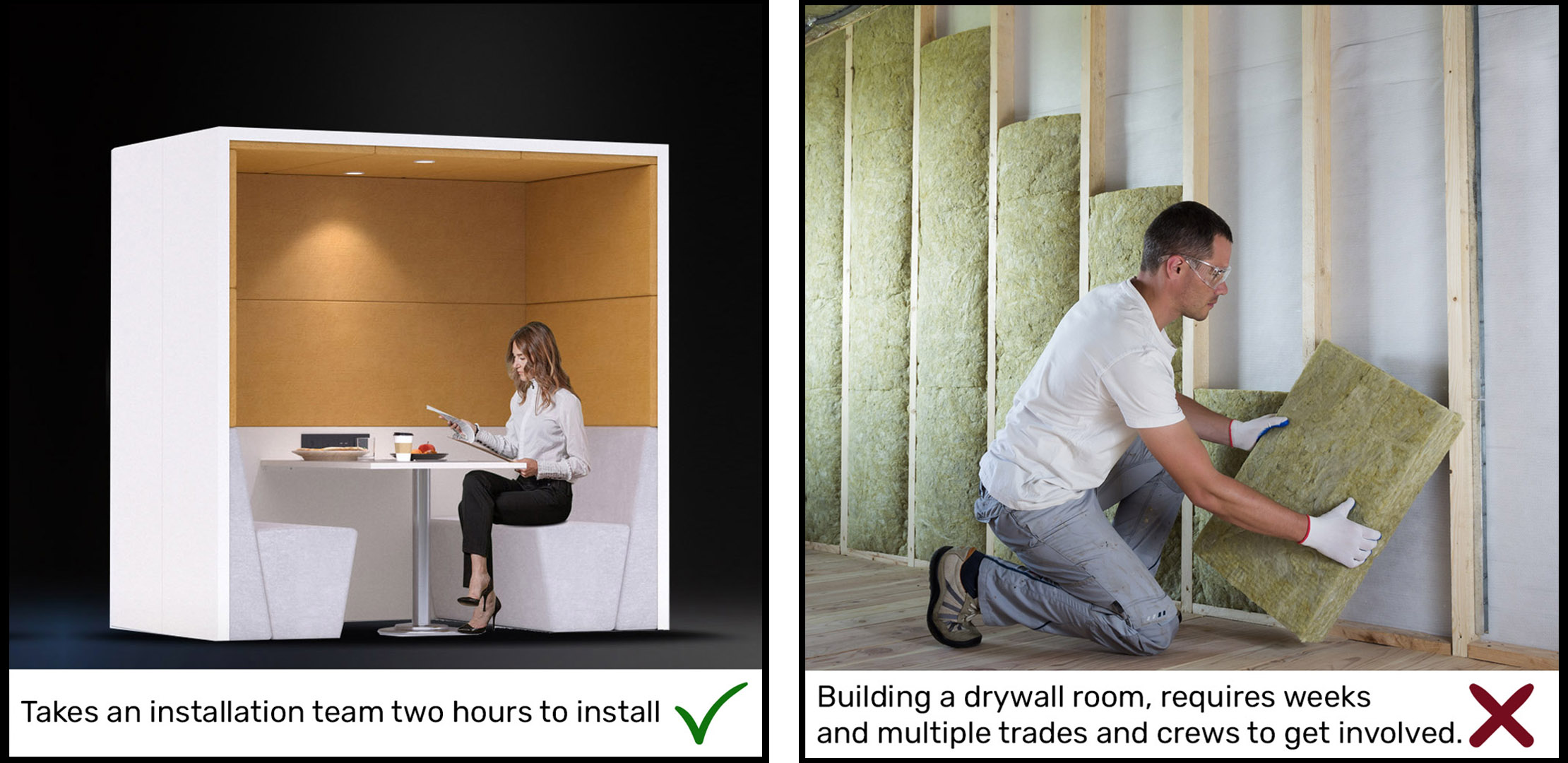Comparing modular phone booths and pods to traditional construction
Phone booths and modular products are increasingly popular as companies seek to avoid the hassles of traditional construction and increase the flexibility and productivity of their workplaces.
Our view is that the benefits of modular booths, pods and modular workspace products far outweigh the drawbacks. Below we seek to cover three main points of comparison to traditional construction.
- Time
It’s a well known fact that the permitting process in many jurisdictions are increasingly taking longer and longer to review plans and issue building permits. Building in traditional conference rooms, offices and private spaces takes considerable time just for planning and permitting not to mention the actual work.
The typical construction process typically requires working with an architect to draft a detailed plan and scope of work. The drawings are then submitted to the building department for permit review where it’s likely that they will require further information and possibly changes to the plans. Once the plans are approved additional time and resources are required to bid and select a qualified contractor to perform the work.
Once a contractor is selected and the permits are approved, the actual work onsite requires considerably more time and disruption than a simple installation of a modular booth.
For example, the Spaceworx Decibel Double (4 per meeting pod) takes an installation team two hours to install versus building a drywall room, which requires weeks and multiple trades and crews to get involved.
A potential drawback to modular pods and phone booths is that most manufacturers have a lead time on production and installation. Lead times typically range from two weeks to twenty weeks depending on the product availability and manufacturing location.
Although modular products will have lead times, it’s important to consider that this process will use considerably less of your time and resources versus hiring architects and managing the design construction process. Additionally, it is not likely that traditional construction can be accomplished any quicker than the pod production lead times.

- Cost
Cost tends to be a major factor when comparing modular workplace solutions to traditional construction. Unfortunately, there is no absolute comparison between the cost of traditional construction and modular booths and pods as so many different factors affect the price of construction. For example, construction in a union office tower in San Francisco, New York or any downtown area is going to cost a lot more than a one story suburban building. In general, our conclusion is that both modular products and traditional construction on average can be comparable in cost. In some cases we are told that it is cheaper to build walls; however, in our view that may be overlooking many factors, not to mention your own time to manage the process.
When comparing construction costs, it is important to factor in the cost for a designer or architect to prepare the plans. The building department also charges fees on permits for reviewing the plans and issuing the permits. The contractors prices are also not set in stone, it’s very common for construction to run into unforeseen issues which end up costing more than expected.
- Flexibility & Sustainability
Flexibility seems to be the most important factor when companies decide to purchase modular pods over traditional construction. The vast majority of companies cannot predict their exact workspace requirements in two years let, alone four or five years.
Many companies have leases that will be expiring in a few years. Investing in the workspace with construction only to abandon it when they move out of the space seems like a waste of resources to most companies. A modular product can be disassembled and reused in a new location.
Even larger companies that have longer term leases tend to reconfigure their offices often to accommodate different requirements as they grow or things change. Modular pods and workplace products tend to have different levels of modularity. For example, the Decibel Double and single booths can be moved, literally slid around, to different locations within an open office using furniture glides. However if the product needs to be moved to a different room, floor or building, it will need to be disassembled and reassembled. Other products such as our Zip Pod are designed with wheels on the base so it can be quickly moved and reconfigured daily depending on the immediate workspaces needs.
Sustainability also plays an important role with most booths and products being built out of recyclable materials. In addition, modular products can be assembled and disassembled multiple times having a much longer life cycle whereas traditional construction ends up in the landfill every time a change is made.

